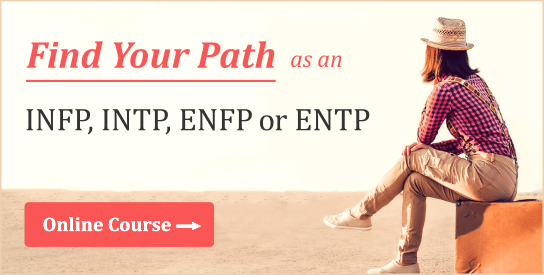
The Enneagram personality taxonomy is comprised of nine basic types. In his classic book, Personality Types, Don Riso refers to the Enneagram 4 as “The Individualist.”
As detailed in our post, Enneagram & Myers-Briggs correlations, the INFJ and INFP are the most likely of the Myers-Briggs types to test as Enneagram Fours. While the INTP and INTJ types more often identify with the Enneagram type 5, they commonly have a 4 wing (e.g., 5w4), which suggests they have significant Four tendencies.
One of Fours’ signature characteristics, according to Riso, is their incessant search for self. As seekers of self and identity, they hope to “find out who they are and what about themselves is significant.” As I observed in my recent post on identity-seekers:
Little is more intriguing to identity-seekers than examining the nature of their own self and getting to the root of who they are. They are constantly “checking in with themselves,” interpreting their experiences in light of their current self-understanding.
Underlying Fours’ identity-seeking is the belief they are in an important sense “special” or “different” from others. This emerges, at least in part, from their distrust of authority and conventional wisdom. At least in the U.S., they often find themselves at odds with the values, interests, and lifestyles of a culture permeated and guided by Extraverted Sensation (Se). As Fours develop and refine their own viewpoints, their culture may seem increasingly strange and absurd to them, which only furthers their sense of being different and unique. Everywhere they turn, they see people living “unexamined lives,” subserviently living out staid societal scripts. Well over a century ago, the philosopher Soren Kierkegaard distinguished between two perspectives that effectively embody those seen in extraverted sensing (“ES”) vs. introverted intuitive (“IN”) types:
There is a view of life which holds that where the crowd is, the truth is also [i.e., the ES view]…There is another view of life which holds that wherever the crowd is, there is untruth [i.e., the IN view].
To better understand how and why they differ from the masses, Fours embark on a quest of self-discovery. They strive to get to the bottom of why it is they see things so differently from others. They want to grasp the essential nature of the self that gives birth to their unique and unconventional perspectives. This thirst for self-understanding is what drives identity-seekers and imbues their lives with meaning and purpose. Once again, Kierkegaard is instructive:
What I really need is to get clear about what I must do…What matters is to find a purpose, to see what it really is that God wills that I shall do; the crucial thing is to find a truth which is truth for me, to find the idea for which I am willing to live and die.
Here Kierkegaard furnishes additional key insights into the Enneagram 4. One is their need for personal truth. For identity-seekers, not any truth will do, but only that which they experience as personally meaningful or significant; truth must also be drenched in meaning. In his Concluding Unscientific Postscript, Kierkegaard refers to this as subjective truth, which in his view, is the only truth that really matters. In modern parlance, we often use the word passion to describe that which resonates most deeply and intensely with us. It is this sense of passion and resonance that Kierkegaard was referencing.
Kierkegaard also highlights Four’s deep-felt need to identify their purpose, to “get clear about what I must do.” In other words, their search for self is also a search for a vocation, one which can serve as a reliable vehicle for self-expression. Indeed, without a suitable means of expressing their ideas, feelings, or insights, Fours are apt to feel dissatisfied and incomplete, concerned that no one will ever see or understand them for who they really are. Some may even fear that they will go to the grave having never been understood by anyone, thus imbuing their quest with a sense of urgency.
The mission of the Enneagram 4 can thus be seen as marked by two primary goals: self-understanding and self-expression. The former is in large part an introverted (I) objective, while the latter entails a translation of their inner world into an extraverted (E) form. Both elements are necessary in order for the Four to feel psychologically whole and satisfied.
Enneagram Type 4: 4w3 vs. 4w5
As introverts, Fours can be inclined to believing that the introverted element (i.e., self-knowledge) must precede self-expression and that additional self-insight is required before authentic action is possible (see our post, Why INFPs, INTPs, INFJs, and INTJs Struggle to Act, for more on this). However, according to Riso, self-knowledge and self-expression should not be seen as independent processes, but symbiotic ones: “In the creative moment, Fours…not only produce something beautiful, but discover who they are.”
In other words, self-discovery and creative work go hand-in-hand. Consequently, many Fours feel that identifying a creative career or vocation is a critical part of their search for self. This is especially true for those with a 3 wing (4w3s), who are particularly concerned with creative achievement. Those with a 5 wing (4w5s), Riso maintains, tend to “create more for themselves.” Compared to 4w3s, they focus less on the E element (e.g., productivity, success, accolades, etc.) of their pursuits.
There is another way of looking at this, however. It may be that 4w3s see creative productivity as a necessary route to making a living doing what they love, one that can furnish them with more time to function authentically. In type speak, they see extraverted success as a means to greater introverted freedom. While 4w5s certainly don’t enjoy compulsory or inauthentic work (e.g., “a day job”), they are more patient, and often more perfectionistic, with respect to their introverted process than 4w3s are. They would rather write one great book or make one ground-breaking album than produce 10 of lesser quality or originality. In short, these two subtypes differ in the sorts of concessions they are willing to make: 4w3s are more willing to make compromises in their creative work to render it more palatable to the masses, whereas 4w5s may sacrifice more of their time to a day job in order to maintain the purity of their introverted pursuits.
Regardless of their particular subtype, Fours seeks a life of meaningful self-reflection and creative expression. They aim to figure out who they are and what they were born to do, and then to act in accordance with that understanding. They want their guidance and direction to come from within so as to ensure that their course is an authentic and meaningful one. Despite these good intentions, Fours must eventually come to terms with the fact that, in order to get what they want, some measure of compromise is required. As much as they might like to, they can’t support themselves through self-reflection alone. Food won’t find its way onto the table unless they do something, irrespective of how ready or prepared they feel. Decisions must be made and enacted apart from perfect self-knowledge. While doing so may at first smack of inauthenticity, in some cases, it may be a blessing in disguise. If as Riso suggests Fours discover themselves through creative work, then a little outside pressure to jumpstart the process may not always be a bad thing.
Final Remarks for INFJ / INFP Fours
According to author and psychoanalyst Allen Wheelis, arriving at a firm sense of identity is now more difficult than ever. Not only must one contend with an ever-expanding number of life roles and paths, but the world is perpetually changing at a breathtaking clip. And because the world is changing so rapidly, Wheelis suggests that maintaining a fluid sense of self may have adaptive advantages. Those incapable of changing with the times may, among other things, find themselves out of work. While the prospect of a fluid identity is apt to be met with acceptance or even excitement among extraverts, it can be a distressing thought for introverts aiming to solidify their sense of self and vocation. In any event, Wheelis’s insight may shed some light on the inherent difficulty of introverts’ self-knowledge project. It may be that Fours fear, even subconsciously, that cementing their identity puts them at risk of becoming obsolete or left behind, making continued functioning as seekers a safer bet.
Another approach to dealing with rapid societal change is to focus less on self-knowledge and more on acquiring “objective” or scientific knowledge. According to Riso, this is the preferred approach of the Enneagram Five, especially those with a 6 wing (i.e., 5w6). Unfortunately the Four is unlikely to consider this a tenable solution, seeing the self and its interests as their primary source of meaning and value.
In the end, the Four may have little choice but to take the artist’s path, including finding ways of navigating its attendant hardships and challenges. The Four’s life is a continuous and mutually-enriching dialogue of identity-seeking and creative self-expression. So as they grow in their self-understanding, their creative work becomes more powerful and refined. Likewise, as they develop as creatives, they feel more attuned and connected to their essential self. While Fours should never expect to “arrive” or achieve absolute certainty in their self-understanding, they can celebrate each step, however small, toward greater clarity and authenticity in their life and work.
If you’re a Four looking to better understand yourself and your path in life, you’re in the right place. Not only have we written extensively about introverted (I) and intuitive (N) types in our books and online articles, but we’ve also developed an online course, Finding Your Path as an INFP, INTP, ENFP or ENTP, which has proven very helpful to INFP or INTP Fours (or those with a 4 wing) seeking to better understand their personality, identity, life purpose, and more.

Kevin Deegan says
Wow, this is very helpful. I’m an INFP 4w5 and this post and your prior posts have done a great job of helping me figure out the many nuances more generalized writings have not. I definitely see the huge difference between an achievement oriented INFP 4w3 and a self reflective 4w5, in the degree to which the 4w3 creates for achievement of external standards and the 4w5 creates almost exclusively for themselves.
The latter of which, while spiritually fulfilling and potentially contributive at a higher level, can be utterly impractical in everyday reality and in need of “compromise” to pay the mortgage.
Thanks for the great work. I read many of your posts regarding all things INFP and learn something new each time. I’ve read the work of many MBTI authors and yours stand out for both their research and their intuitive insight.
Pbzepellin says
You hit the nail on the head with your statement about 4s subconscious fear of defining themselves making continued existence as seekers the “safe” choice .. brilliant insight there.
Isabel says
Very interesting article. I am an INFJ and 5 wing 4 with nearly equal distribution of 5 an 4 traits and it makes a lot of sense. Thanks for all the great work!
Laura says
As 4w5 I found this post very interesting! I always test INFJ but I ‘m pretty sure I’m an INFP. Either way I’m surely an Enneagram Four and the worst thing I can imagine is to lose the sense of ‘who’ I am. If I no longer know who I am or what I really want, I feel useless and out of place wherever I go. I agree with the fact that 4w5 tend to ‘create more for themselves.’ Of course I’d like to share my creative achievements with the world one day, but it isn’t the most important thing. Your MBTI posts are the most useful and insightful I’ve found this far. I love them all. Thank you!
Lauren says
It’s interesting how enneagram corelates to MBTI. Personally I’m INFP, but a 9w1 instead of a 4.